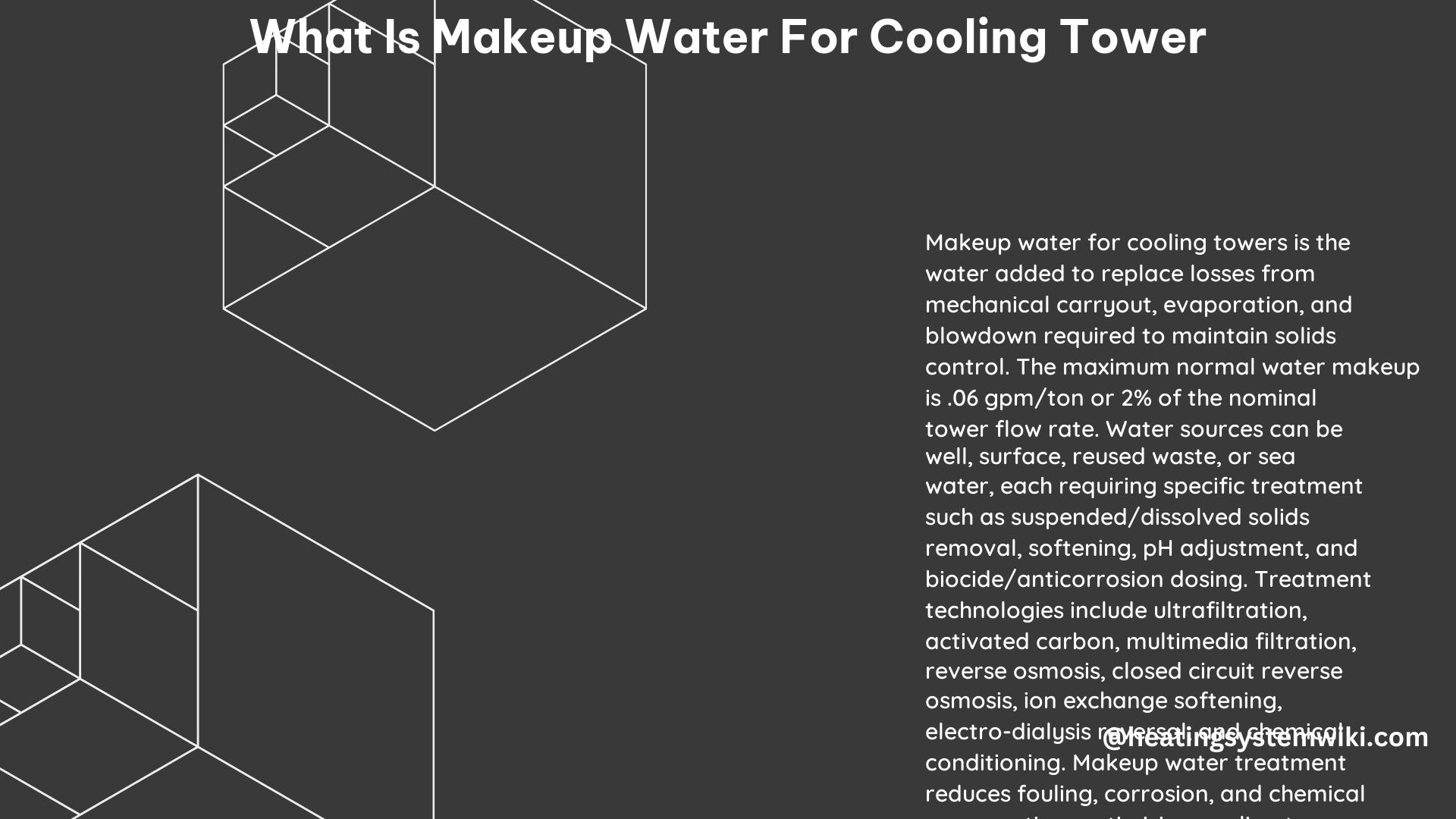Makeup water for cooling towers is the water added to replace the water lost due to evaporation, windage, and blowdown. This water is essential for maintaining the proper water balance and ensuring the efficient operation of the cooling system. The quality of the makeup water is critical, as impurities can lead to fouling, scaling, and corrosion, which can negatively impact the performance of the cooling system.
Understanding Makeup Water Requirements
The maximum normal water makeup for a cooling tower system is typically 0.06 gallons per minute per ton, or about 2% of the nominal tower flow rate. This means that for a 1,000-ton cooling tower, the maximum normal water makeup would be approximately 60 gallons per minute.
The actual makeup water requirements can vary depending on several factors, including:
- Evaporation Rate: The rate of water evaporation from the cooling tower is influenced by factors such as ambient temperature, humidity, and the tower’s design and operation.
- Windage Losses: Windage losses refer to the water droplets that are carried away by the air flow through the tower, which can account for up to 0.2% of the total water flow.
- Blowdown Rate: Blowdown is the process of removing a portion of the circulating water to control the concentration of dissolved solids, which can lead to scaling and fouling. The blowdown rate is typically 0.5% to 2% of the total water flow.
Makeup Water Quality Considerations

The quality of the makeup water is critical for the proper functioning of the cooling tower. Common impurities in makeup water include:
- Suspended Solids: Particulate matter, such as silt, clay, and organic matter, can lead to fouling and reduced heat transfer efficiency.
- Conductivity/Total Dissolved Solids (TDS): High levels of dissolved solids can increase the risk of scale formation and corrosion.
- pH: The pH of the makeup water should be within the optimal range (typically 6.5 to 8.5) to prevent corrosion and scale buildup.
- Alkalinity: High alkalinity can lead to scale formation and increased chemical treatment requirements.
- Calcium and Magnesium Hardness: Hard water can contribute to scale formation and reduced heat transfer efficiency.
- Silica: Silica can form hard, adherent deposits on heat transfer surfaces, reducing efficiency.
- Chlorides and Sulfates: These ions can contribute to corrosion of metal components in the cooling system.
- Bacteria: Microbial growth can lead to biofouling and increased chemical treatment requirements.
Makeup Water Treatment Methods
To address these impurities, various water treatment methods can be employed, including:
- Filtration: Mechanical filtration, such as multimedia filtration or cartridge filtration, can remove suspended solids.
- Softening: Ion exchange resins can remove calcium and magnesium ions, reducing the risk of scale formation.
- Demineralization: Reverse osmosis or deionization can remove dissolved solids, including salts and minerals.
- Disinfection: Chlorination, UV treatment, or ozonation can control microbial growth.
- pH Adjustment: Acid or base addition can adjust the pH to the optimal range.
- Antiscalants and Dispersants: Chemical additives can inhibit scale formation and disperse suspended solids.
The specific treatment methods required will depend on the source and quality of the makeup water, as well as the manufacturing requirements of the cooling system. For example, surface water from rivers or lakes may require more extensive treatment than groundwater or seawater.
Innovative Makeup Water Treatment Solutions
Leading companies in the water treatment industry, such as DuPont and Lenntech, offer advanced solutions for cooling tower makeup water treatment:
DuPont Solutions
- Ultrafiltration: DuPont’s ultrafiltration membranes can remove suspended solids, bacteria, and some dissolved organics from the makeup water.
- Ion Exchange Resins: DuPont’s ion exchange resins can effectively remove hardness, silica, and other dissolved ions from the makeup water.
- Reverse Osmosis: DuPont’s reverse osmosis systems can significantly reduce the concentration of dissolved solids in the makeup water.
Lenntech Solutions
- Multimedia Filtration: Lenntech’s multimedia filtration systems can remove suspended solids, turbidity, and some dissolved contaminants from the makeup water.
- Activated Carbon Filtration: Lenntech’s activated carbon filters can adsorb organic matter, chlorine, and other contaminants from the makeup water.
- Reverse Osmosis: Lenntech’s reverse osmosis systems can produce high-purity water by removing dissolved salts, minerals, and other impurities.
- Ion Exchange Softening: Lenntech’s ion exchange softening systems can effectively remove hardness-causing calcium and magnesium ions from the makeup water.
- Electrodialysis Reversal: Lenntech’s electrodialysis reversal systems can selectively remove dissolved ions, such as chlorides and sulfates, from the makeup water.
These advanced water treatment solutions can help increase the cycles of concentration in the cooling tower, reduce water consumption and blowdown waste, and lower the overall chemical consumption for water conditioning.
Conclusion
Makeup water for cooling towers is a critical component of the cooling system, and its quality can significantly impact the system’s performance and efficiency. By understanding the makeup water requirements, identifying common impurities, and employing appropriate water treatment methods, facility managers and engineers can ensure the optimal operation of their cooling towers. The innovative solutions offered by industry leaders like DuPont and Lenntech can further enhance the performance and sustainability of cooling tower systems.
